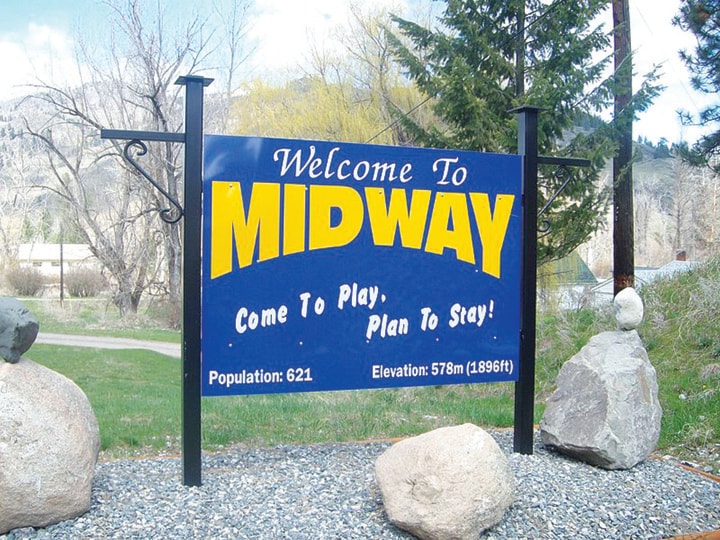Many theories exist about how Midway got its name.
To begin with, Midway was previously known as Eholt’s, Boundary City, and Boundary Creek. The first of these was in honour of Louis Eholt (1840-1911), who pre-empted the future townsite around 1884 and for whom a Boundary railway junction was later named.
Eholt’s was first mentioned in a letter from land surveyor J.P. Burnyeat to the commissioner of lands and works dated December 1891 and quoted in Grand Forks: The First 100 Years: “A wagon road exists from Eholt’s to Grande Prairie, 25 miles, but on American territory … there is a deep gulch and, in my opinion, affords a good pass for a wagon road, connecting Eholt’s and Osoyoos with Grande Prairie on the Canadian side …”
A post office application was filed on Sept. 7, 1893 as Boundary City, but when the office opened on Jan. 1, 1894, it was called Boundary Creek.
In 1893, Capt. Robert C. Adams of Montreal purchased the property and had a townsite laid out. By some accounts, it was called Midway from the get-go while others say it was Boundary City first and renamed Midway the following year.
In any case, Adams’ rationale for the name was explained in the Boundary Creek Times of Dec. 26, 1896, but only rediscovered a few years ago by Al Donnelly of the Boundary Historical Society:
“Capt. Adams … says he puzzled for days thinking of a name that would be both suitable and catching. What he wanted was a name easy to pronounce and easy to remember, but to name a town is not so easy a task after all. Those who know Capt. Adams, however, also know that even in a matter of this kind he would employ original methods — and he certainly did. He went straight through Webster’s Unabridged till he came to the letter M — how long it took him he does not say — and Midway immediately struck his fancy.
“It was short and had a pleasing sound; moreover it expressed distinctly two ideas topographically and geographically correct; The town is exactly in the centre of the whole district, and is also the midway point between the Rocky and the Selkirk ranges. So the town was called Midway accordingly.”
(This doesn’t make sense, however — Midway is to the west of both the Rockies and the Selkirks.)
A petition was submitted to postal authorities on April 4, 1894 requesting the post office be renamed Midway. The change took effect on Nov. 1.
Subsequently, others found additional reasons why Midway was an appropriate name. In a 1905 letter to the Geographic Survey of Canada, postmaster Edward A. Hain suggested Midway was named “on account being about as nearly possible halfway, or midway, between the then-nearest point of railway communication, namely Marcus on US side, and Penticton on Canadian side, where early prospectors had to get their supplies.”
R.A. Brown in a separate letter to the Geographic Survey suggested it was “named on account of it being halfway between Grand Forks and Osoyoos Lake.”
The Midway Advance of Dec. 11, 1899 wrote: “The town was named Boundary City but because of Boundary Falls a new name was required. Capt. Adams eventually decided upon Midway, as the town is approximately midway between the Rocky Mountains and the Pacific Ocean.”
The BC Centennial Directory of 1967 suggested: “Being at about the halfway mark on the Dewdney trail passing through it, Boundary City soon was generally referred to as Midway. Eventually the name stuck simply because it avoided confusion with the other smelter town of Boundary Falls …”
According to the 2001 Boundary Visitors Guide: “Generally accepted is the theory that the village lies midway between the Pacific Ocean and the Rocky Mountains. The other is that it’s midway between heaven and hell!”
There’s also the notion that Capt. Adams was influenced by Midway Plaisance, the Chicago park at the centre of amusements during the 1893 World’s Fair, which resulted in midway becoming a byword for fairs and carnivals. While this sounds plausible, it did not appear in print until 1945 in Rupert W. Haggen’s Origin of Place Names in Boundary District manuscript.
Midway incorporated as a village in 1967.
